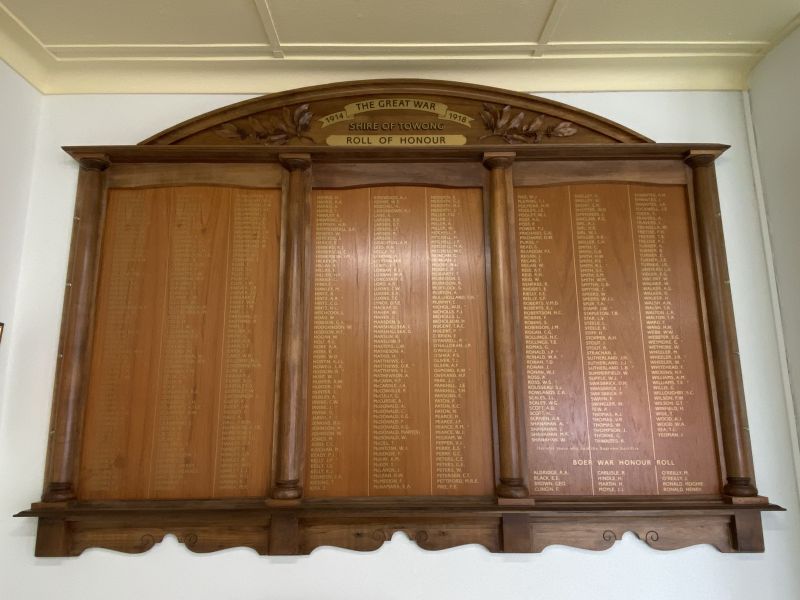Frederick (Fred) Jarvis
Fred was born on the 23rd of February, 1897, at Tallangatta, Victoria. He would be the fifth of eleven children for Frederick William and Emily (née Haeffner) Jarvis. The family lived and farmed on a property adjacent to the Noorongong State School for a number of years. Frederick snr. also worked as a teamster.
Fred attended the Corryong State School in his early years. He also served two years with the Senior cadets of the 21st Battery Australian Field Artillery. Fred needed his parent’s permission to enlist as he was under the age of 21. His service record includes a letter, written from his mother, stating that she was “quite willing” for her son to enlist. At the time of his enlistment on the 20th of September, 1915, he was a single, 18 year old clerk. Fred was allocated the Regimental Number 9486 and was placed in the 1st Reinforcements for the 6th Field Artillery Brigade.
This unit embarked on HMAT A34 Persic on the 22nd of November, 1915, at Melbourne. It disembarked at Suex on the 21st of December, 1915. Five days later Fred was attached to the 18th Battery of the 6th Field Artillery Brigade, 2nd AIF Division at Toura. Approximately one month later his unit embarked on HT Arcadian at Alexandria, disembarking at Marseille in the south of France six days later.
The journey from Marseille in the south to Le Havre in the north took 58 hours. The initial battle of the Somme began on 1st July where the 1st ANZAC Corps suffered 23,000 casualties. In September, 1916, the 18th Battery relieved the 1st ANZAC Corps at Menin Gate, where they spent the next 17 days and were to eventually spend the winter in terrible conditions.
Gunner Colin Twist, also a member of the 18th Battery, describes these days.
“3.9.16 Took Thiepval & Moquet Farm. Had to retire midday from Thiepval with heavy casualties. Fighting all night. Saw two of our planes descend near our lines. One engine trouble and one wounded pilot. 6 wounds from Fokker.
4.9.16 Guns came out of action at 4pm. Fritz started shelling us at 7pm. One horse wounded. Raining cats and dogs … mud up to ankles. Harnessed up and moved out. Fritz still shelling. Moving about 1 mile and stayed there till morning. Absolutely worst night I have ever experienced. Wet through and foot deep I walked about all night. I think rum saved our lives.”
After a break from the Somme, the battery moved back into the region. Gunner Twist continued to write.
“28th to 31 Oct. What happened between these two dates I don’t rightly remember. What with forced marches, nothing to eat and no sleep. Mud up to our thighs. It was an absolute nightmare.
1.11.16 Arrived firing line Longneval … Again in the Somme battle. Shot one of our horses .. broke his leg in the mud. Shell just missed our dugout and killed 3 men.
2.11.16 Shelling all around. Oh! What a hole – a hell hole. Saw a ‘Tank’.
14.11.16 Big stunt in morning. Our lads took some tranches on right. Pearce killed at wagon lines. Recently came in from D.A.C. [Divisional Ammunition Column]. Fritz strafed pits in evening and killed one wounded one.
15.11.16 Fritz strafed our trenches like hell. Bdr [Bombardier - Lance Corporal] White wounded with bomb dropped from Taube [a type of German airrcaft]. Shell dropped 10 yards away whilst I was asleep and wounded one horse which had to be shot.”
On the 9th of February, 1917, he was admitted to the 1/1st South Midland Division Casualty Clearing Station suffering from appendicitis. Two days later he was moved to the 38th Casualty Clearing Station with typhoid fever.
Fred’s Red Cross File explains what happened to him.
“Died of Typhoid
This man was admitted to the Hospital on 11-2-17 suffering from Enteric fever, and died on 23-2-17. He was suffering from profound anemia and did not improve though every effort was made to save him. He was semi-conscious during his stay in hospital and suffered no pain. He was buried in the Military Cemetery adjoining. His effects were sent to the D.A.G. Base on 8-3-17.
Ref. letter reed. From O.C., 38th C.CS.
4-4-17”
Fred was buried in the Heilly Station Cemetery, Mericourt-L’Abbe, Picardie, France. He is also remembered on the Australian War Memorial Roll of Honour, the Noorongong Honour Roll, the Noorongong School site, the Honour Roll of the 18th Battery’s first twelve months (see image) and the Towong Shire Boer War and WW1 Roll of Honour at Tallangatta, Victoria. For his service, he was awarded the 1914-15 Star, the British War Medal and the Victory Medal.
 Stephen Learmonth
Stephen Learmonth